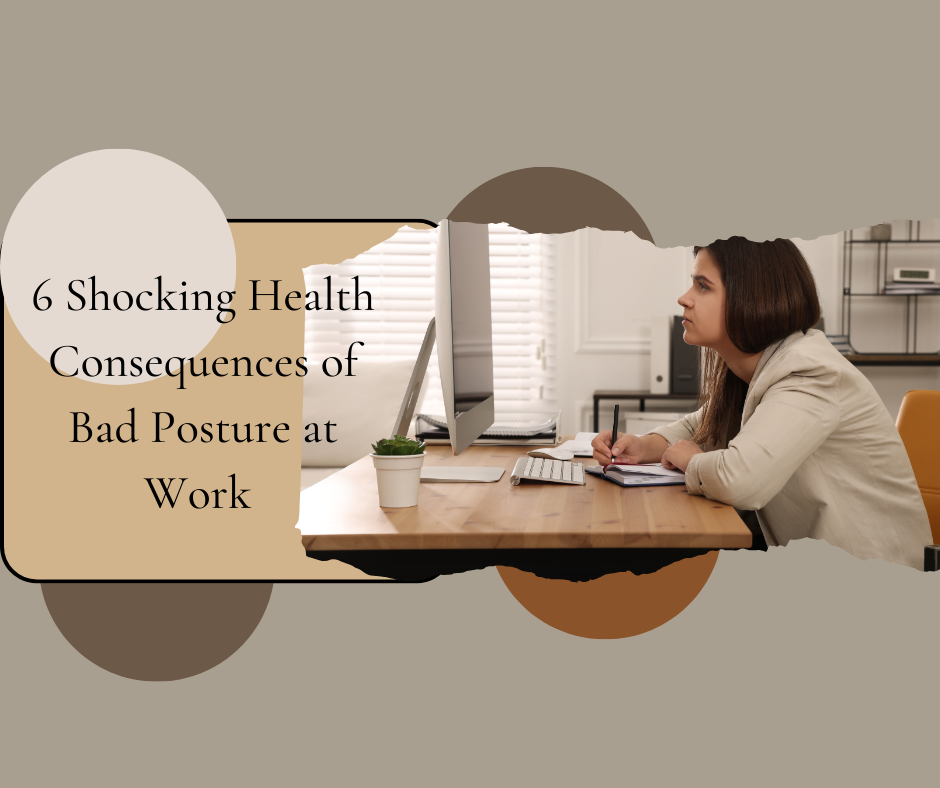
6 Shocking Health Consequences of Bad Posture at Work
The Silent Epidemic of the Office Chair
In the modern office, a silent epidemic is spreading, often unnoticed, as workers spend hours tethered to their desks, peering at computer screens, and slowly succumbing to the insidious creep of poor posture. It's a common sight: slumped shoulders, strained necks, and curved spines are as much a part of the office landscape as the ubiquitous swivel chairs and keyboards. But why is poor posture so prevalent in these seemingly innocuous settings?

A Widespread Posture Predicament
The prevalence of poor posture and its associated discomforts among office workers is alarmingly high. Data highlighted in the International Journal of Innovative Research in Medical Science reveals that 78% of workers report experiencing musculoskeletal pain, with a notable 84% of them attributing this to less-than-ideal sitting postures during work (1). Complementing this, a study published in BMC Public Health underscores the relationship between posture and workplace productivity, emphasizing ergonomic practices' critical role in fostering a healthy and efficient work environment (2).
The Office Environment: A Culprit?
But why, in an age where we know more about the human body than ever before, is poor posture so rampant among the cubicles and coffee machines? The answers are multifaceted:
- Ergonomic Ignorance: Many office environments are not designed with human anatomy in mind. Desks and chairs are often one-size-fits-all, neglecting the diverse physical needs of individual workers.
- Technology's Tyranny: The omnipresence of computers and mobile devices encourages forward head posture as we lean into our screens, straining our necks and upper backs.
- Sedentary Schedules: Office work often involves long periods of sitting, a static posture that the human body has not evolved to maintain for extended times.
- Productivity Pressures: Intense focus on tasks at hand can lead workers to ignore their bodies' needs, remaining in unhealthy positions for too long without taking breaks.
The Six Surprising Health Implications of Poor Posture
Beyond the expected backaches and neck pains, poor posture can stealthily undermine our health in unexpected ways:
- Incontinence and Digestive Issues: Slouching increases abdominal pressure, contributing to stress incontinence, where involuntary urine leakage occurs during activities like coughing or laughing. Poor posture also compresses digestive organs, leading to slowed digestive processes and issues such as constipation and heartburn due to acid reflux (3).
- Poor Circulation and Lung Function: Prolonged periods of poor posture, especially while sitting, can impede blood circulation, increasing the risk of varicose veins and deep vein thrombosis (blood clots in the legs). Additionally, slouching compresses the lungs, reducing their capacity and efficiency and impacting the oxygen supply to the body.
- Musculoskeletal Disorders: Chronic bad posture places undue stress on muscles, joints, and ligaments, leading to conditions like tension and pain in the neck, upper back, lower back, and shoulders, as well as more serious conditions like tendonitis or carpal tunnel syndrome.
- Spinal Misalignment: Continual poor posture can lead to a curvature of the spine, causing a range of issues from nerve compression to altered body mechanics, impacting overall health and mobility.
- Increased Fatigue and Decreased Energy Levels: Poor posture can cause increased muscle strain and tension, leading to greater fatigue throughout the day and impacting both physical and mental energy levels due to inefficient posture maintenance.
- Negative Impact on Mental Health: There is growing evidence linking poor posture with negative effects on mental health. Slouching and poor body alignment can contribute to feelings of depression and decreased self-esteem. The physical discomfort and chronic pain associated with poor posture can also exacerbate stress and anxiety.

Conclusion: A Call to Action
In the end, combating poor posture is about making small, consistent changes to our daily routines. Here are three steps to get started:
- Conduct an Ergonomic Assessment: Evaluate your workspace and make necessary adjustments.
- Commit to Regular Breaks: Set reminders to take short breaks for stretching and walking.
- Strengthen and Stretch: Incorporate exercises into your daily routine that strengthen the back and core muscles.
By taking these proactive steps, you can not only improve your posture but also enhance your overall health and productivity. Let's not underestimate the power of posture; it's the foundation upon which our work and well-being stand.
References:
1. Al-Nakhli, H. H., & Bakheet, H. G. (2020). The Impact of Improper Body Posture on Office Workers’ Health. International Journal of Innovative Research in Medical Science, 5(05), 147 to 151. https://doi.org/10.23958/ijirms/vol05-i05/873
2. Wang, H., Yu, D., Zeng, Y. et al. Quantifying the impacts of posture changes on office worker productivity: an exploratory study using effective computer interactions as a real-time indicator. BMC Public Health 23, 2198 (2023). https://doi.org/10.1186/s12889-023-17100-w
3. Harvard Health Publishing. (n.d.). 3 Surprising Risks of Poor Posture. Harvard Health. Retrieved 1/21/2024
